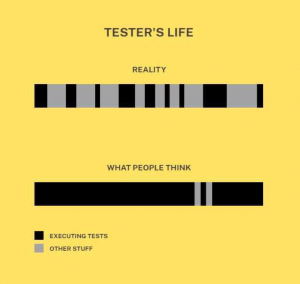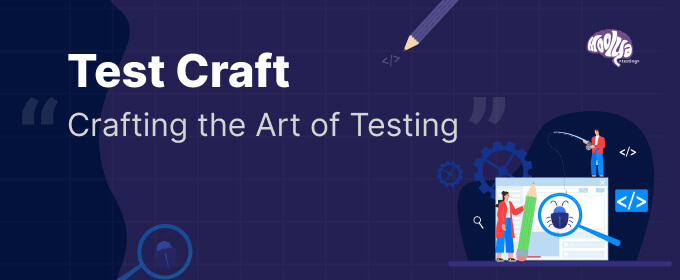Albert Einstein once said, “If you can’t explain it to a six year old, you don’t understand it yourself.”
So as passionate testers ourselves we take it on us to explain the art of testing in the simplest way possible.
Let’s start at the beginning.
What is Testing?
It is the process used to identify the correctness, completeness, and quality of a developed computer software.
Simple as it sounds, the process itself can pose a lot of challenges. And that’s what makes testing far more interesting. Many people have this misconception that testing is easy and hence mundane. But let us present to you a challenging scenario.
How to do Testing without Test Cases and Test Ideas?
In some situations you will have No documentation, No test cases/Ideas but still you are given an application to test..
What will be your strategy to test?
We would say it’s a blessing in disguise because you as a tester can assess the application and determine the issues by yourself. So here’s what you should do
- Explore the application first.
- Try to understand the application behaviour also the functionality, how the features are working…
- Collaborate with team members to discuss various aspects of the application.
- Make a note of all important points because no one can remember all the functionality In a particular application.
This brings us to another pivotal question.
Why do we need testers at the start of the project?
Let’s see the below image and imagine the chaos that goes on within the entire phase of product development and execution. What can we learn from this?

As a tester it is your task to solve the customer’s pain points which have both business and technical aspects adhered to them. In short, testing should be conducted in tandem with development.
Hence we will now talk about the agile way of testing.
Testing in Agile- Test Strategy and Test Ideas
- In Agile development, testing needs to happen early and often. So, instead of waiting for development to be finished before testing begins, testing happens continuously as features are added.
- Testing in traditional development typically includes a test plan. But a well-documented test plan is not common in Agile development. So, there needs to be an Agile test strategy rather than an Agile test plan.
No matter which Agile test methodology you take, your STRATEGY should include:
- Purpose (defined by the user story).
- Objectives (test ideas).
- Scope (what needs to be tested).
- Methods (how tests will be run).
Now some of us also might assume that testing is all about executing the test cases. That again points to the misconception that testing a banal repetitive work. However, it’s far from anything like that
Testing != Test Execution
It’s way more than that, it also includes:
– Exploration – Analysis
– Investigation – Debugging
– Questioning – Support
– Reporting
– Scripting
– Preparing Strategy And much more.
Now that we are clear on the fact that testing requires a strategic viewpoint towards a digital product let’s learn about some of the crucial things about this art.
Important In Testing
- Why to Test- Asking Questions
- What to Test- Which Module or what exactly is required to test (Context to test)
- How To test- Selecting tools or the way of testing
Yes, it’s true. Testing is an art in itself. It covers a wide range of things. It also demands meticulous planning and execution. But the art of testing depends entirely on the context.
Context Driven Testing
- The context-driven testing is a model based on the context of the project rather than going by books methodology
- Context driven testing gives more importance to the current context of a specific project rather than blindly following an established method/process. Because every project we deal with has different circumstances like,
- Documented or undocumented requirements
- Testing and development teams belong to different companies
- Tight schedules or relaxed schedule
- Testing tools used
- Availability/composition of testing team
- Type of the project etc.
COP FLUNG GUN
Have you heard about Mobile app testing with COP (who) FLUNG GUN?
It’s about time that you do.
User scenarios and Functionality may be the major theme while testing any app(mobile or desktop).
This mnemonic COP FLUNG GUN is to remind testers of what to think about when they are creating tests.

Scripted VS Exploratory Testing
By now we know that a tester’s job is like a generalist. They’ve to be prepared for any given scenario. This makes this art even more intriguing. In this section let us see what are the pros and cons of both of the scenarios.

With that knowledge let’s see what actually being a tester encompasses in its truest essence.
QA Engineer’s work

So naturally a tester’s life doesn’t only consist of testing. But a tester must involve themselves in various other aspects of the product and the business itself.
Tester’s Life

You might also come across rumors that a tester’s career is quite stagnant. Well, as professional testers with years of experience between us we can assure you that it’s not.
Automation is not Auto-Magic
Many companies assume that automation might solve all their testing problems. But the reality is that you cannot automate everything. And Selenium is not equal to automation.

Conclusion
So now we know that testing is a separate profession and art by its own right. We are definitely not here to play second fiddle to the dev teams. Instead we conduct testing and provide interventions in order to solve real life business problems.
14